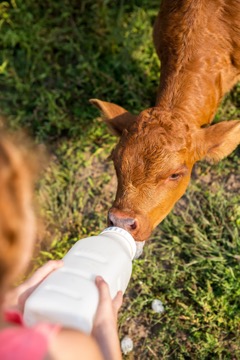Source: Utah State University
Authors: Reganne Briggs, Katelyn Barsnick, Cheyenne Reid, Ashley Longmore
Having bottle-fed calves on the ranch is common for beef producers. The most likely scenarios are a cow has died, a cow isn’t giving enough milk, or a twin has been rejected. All these scenarios are likely to happen, which results in an orphan calf. Bottle-feeding a calf is straightforward; however, there are limited resources, specifically for beef producers, looking for bottle-fed calf management strategies. When bottle-feeding a beef calf, there are some things to consider, such as feeding colostrum, selecting and using milk replacers, and weaning the calf. Many of the resources on bottle-calf management come from the dairy industry; however, beef producers can tailor dairy industry strategies to fit their own operation.
Colostrum
In terms of calf health, colostrum is liquid gold. When a calf is born, they are agammaglobulinemic, which means the calf has little to no immunity (Godden, Lombard, & Woolums, 2019). Colostrum not only provides the calf with immunoglobulins but is also very nutrient-dense. With this in mind, colostrum is extremely important since it provides the calf with its first line of defense against disease.
The most efficient way to feed colostrum is for the calf to suckle its mother; however, this is not always possible with bottle calves. Colostrum can be obtained by milking the mother, using colostrum that has been previously acquired, or purchasing commercially available colostrum replacer (Walz, 2019). A calf should be fed 5% to 6% of its body weight of colostrum at first feeding (1.5–2 quarts for a 70-pound calf) (Parish, 2019). Colostrum should be given to calves as soon as possible after birth. The most optimal period for absorption of immunoglobulins occurs before 4 hours of age and starts to decrease after 12 hours (Weaver et al., 2000). Calves will lose the ability to absorb antibodies across the gut wall at 24 to 36 hours after birth (Stott et al., 1979). A calf that does not voluntarily consume the first feeding of colostrum should be tube-fed colostrum to ensure that the immunoglobulins are transferred as soon as possible. When tube-feeding a calf, it is recommended to consult a veterinarian on proper esophageal tube placement. A calf can easily drown or develop severe pneumonia if a tube is improperly inserted and milk replacer is introduced to the lungs.
Diet
Although calves become a mature ruminant one day, in the first few months of life, calves need a primarily milk-based diet to receive needed nutrients. It is beneficial for the calf to consume a whey-based formula that is specific for calves (Wilke & Greenwell, 2022). When using a milk replacer, follow the product directions. Mix the milk replacer with warm water and try to keep the milk replacer temperature consistent between feedings (Parish, 2019).

or Milk and Hay (C)
Source: Penn State Extension
Table 1. Cattle Heat Stress Stages and Clinical Signs
| Age (weeks) | Milk replacera (quarts) | Calf starter (pounds) | Hay (pounds) |
|---|---|---|---|
| 1 | 2.75* | 0 | 0 |
| 2 | 2.75 | 0.1 | 0.5 |
| 3 | 3.25 | 0.2 | 0.8 |
| 4 | 3.75 | 0.4 | 1.1 |
| 5 | 3.75 | 0.9 | 1.2 |
| 6 | 3.25 | 1.3 | 1.3 |
| 7 | 3.25 | 1.5 | 1.5 |
| 8 | 1.75 | 1.8 | 1.8 |
| 9 | 1.75 | 2.2 | 2.2 |
| 10 | 1.25 | 2.6 | 2.6 |
aMilk replacer fed twice, daily
*First 3 to 4 days, feed colostrum
Source: Table adapted from Kochewad, 2013
Weaning

Once a calf is eating 1% to 1.5% of its body weight on a dry matter basis in solid feed, the calf is ready to be weaned off the bottle (Wilke & Greenwell, 2022) Calves who have been eating concentrates may be weaned at 6 to 10 weeks of age (Jones & Heinrichs, 2023). Bottle-feeding a calf is a large time commitment for beef producers, and decreasing the length of bottle feeding may be beneficial. Once calves are weaned from the bottle, it is important to note that calves are small and their nutrient requirements are high; therefore, the calves should be getting nutritionally dense feeds that are digested easily, such as concentrates. Concentrates should be offered two to three times daily as the calf grows and develops to ensure proper rumen development.
Summary
It is common for beef producers to have bottle calves as a result of various factors. Some things to consider when bottle-feeding a beef calf are:
- Providing colostrum.
- Offering hay and concentrates along with milk.
- Weaning when the calf has adequate rumen development.
Offering concentrates such as grain increases the rate of rumen development; therefore, grain-fed calves may be weaned earlier than milk-only-fed calves. These simple strategies will aid in the success of a healthy, growing, bottle-fed calf.
References
- Godden, S. M., Lombard, J. E., & Woolums, A. R. (2019). Colostrum management for dairy calves. Veterinary Clinics: Food Animal Practice 35(3):535–56. doi: 10.1016/j.cvfa.2019.07.005.
- Jones, C., & Heinrichs, J. (2023). Rumen development, don’t wean Calves without it! Penn State Extension. Retrieved April 12, 2023, from https://extension.psu.edu/rumen-development-dont-wean-calves-without-it.
- von Keyserlingk, M. A. G., Rushen, J., de Passillé, A. M., & Weary, D. M. (2009). Invited review: The welfare of dairy cattle—key concepts and the role of science. Journal of Dairy Science, 92(9), 4101–11. doi: 10.3168/jds.2009-2326.
- Kochewad, S. (2013). Calf mortality–causes and control measures. Indian Farming, 62, 23–26.
- Parish, J. (2019). Caring for newborn beef calves separated from their dams [Fact sheet]. Mississippi State University Extension. Retrieved April 6, 2023, from http://extension.msstate.edu/publications/publications/caring-for-newborn-beef-calves-separated-their-dams.
- Stott, G. H., Marx, D. B., Menefee, B. E., & Nightengale, G. T. (1979). Colostral immunoglobulin transfer in calves I. Period of absorption. Journal of Dairy Science, 62(10), 1632–38. doi: 10.3168/jds.S0022-0302(79)83472-4.
- Walz, T. (2019). The importance of colostrum to the newborn calf. Institute of Agriculture and Natural Resources, University of Nebraska – Lincoln. Retrieved April 6, 2023, from https://beef.unl.edu/beefwatch/importance-colostrum-newborn-calf.
- Weaver, D. M., Tyler, J. W., VanMetre, D. C., Hostetler, D. E., & Barrington, G. M. (2000). Passive transfer of colostral immunoglobulins in calves. Journal of Veterinary Internal Medicine, 14(6), 569–77. doi: 10.1892/0891-6640(2000)014<0569:ptocii>2.3.co;2.
- Wilke, K. H., & Greenwell, H. (2022). What you need to know to be a bottle calf’s mama. Institute of Agriculture and Natural Resources, University of Nebraska – Lincoln. Retrieved April 12, 2023, from https://beef.unl.edu/beefwatch/2022/what-you-need-know-be-bottle-calf%E2%80%99s-mama









